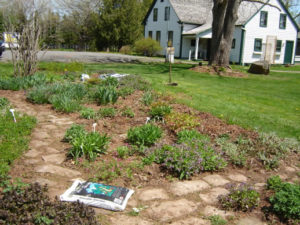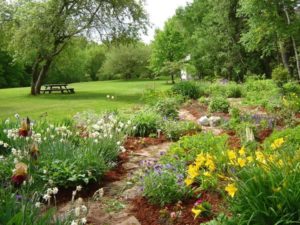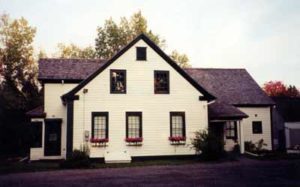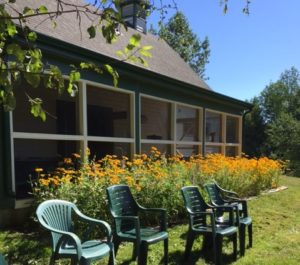Welcome to the Wallace and Area Museum Heritage Gardens
Our garden history:
John Kennedy, the Wall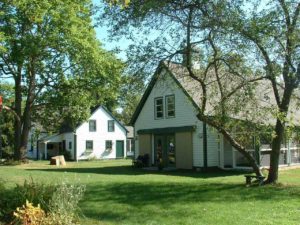 ace and Area Museum’s benefactor, was fond of the museum property gardens and grounds. Many of his original plants and trees can still be found in the largest of the museum’s garden areas.
ace and Area Museum’s benefactor, was fond of the museum property gardens and grounds. Many of his original plants and trees can still be found in the largest of the museum’s garden areas.
The written history of our gardens is a work in progress, with still more documents and interviews to gather. In 1990, when the Wallace and Area Museum Society assumed protection of the property, many enthusiastic and hardworking people have either been employed or have volunteered to keep the grounds and garden areas, with their unique varietals, in prosperous and healthy condition.
Wallace resident Owen Langille worked on the gardens with John Kennedy and his mother Mary Davison Kennedy. These are observations quoted from interview notes:
“John Kennedy started all the bedding plants himself in St. John under artificial light. He had approximately fifteen trays, two feet long and fifteen inches wide, which he transported here from New Brunswick – the usual annuals: snapdragons, verbena, cosmos, marigold. At the front of the house, there was mainly ground cover – periwinkle, as we see in that location today. Hawthorn bushes grew along the driveway.” He remembers that there were beds everywhere – mostly annuals, and a few perennials: iris and daylily. One bed towards the orchard was devoted to dahlias,. The bed was eighty feet long and thirty feet wide. “Mr Kennedy bought approximately one hundred and fifty dahlia bulbs for one dollar apiece from St. John. He bought only the highest quality bulbs and seeds. Some of his dahlias were eight inches across.
There was also a large vegetable garden with more than one hundred tomato plants, all different varieties, including yellow varieties. On the west side of the house there was a trellis with two red tea roses. That was also the location of the flower beds. On the east side of the house there was a bed of mint – the only herb in the herb garden.”
The orchard grew well. Indeed, Mr. Kennedy sprayed pesticides regularly with a large tank sprayer to make sure it did!
The Davison Kennedy property:
One of the original Remsheg Loyalist land grants on 1784, the Kennedy property consists of two hundred and twenty-five mainly wooded acres, including shore frontage on Wallace Bay. A brook runs through the property and empties into the Bay. In the area that is not wooded, an orchard, lawn and perennial gardens are on the west side of the brook, with a fallow field on the east side. An old bridge spanned the brook. A house, barn and several outbuildings were still standing when the Wallace and Area Museum Society became involved.
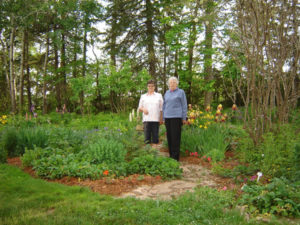
Restoration of the gardens:
In 1992 Penny Lighthall was hired as the first curator of the Wallace and Area Museum. For three summers, horticultural graduates from the then Nova Scotia Agricultural College in Bible Hill developed the museum grounds under the supervision of the curator. The first horticulturist hired by the Society in 1993 was Kim Shand. Rosanne Lord was the museum horticulturist in 1994, Kim Lake in 1995 and Paul Muto in 1996-1997. Muto was retained as Outside Site Manager in 1998. Kim Shand drew extensive plans for new garden beds, foundation plantings, a rose garden and herb garden in 1993, and carried out meticulous research on Victorian varietals for the garden, which she envisioned as mid-Victorian era (1840 to 1860).
Volunteer Glenda Waugh notes that the garden beds evolved from plants that were here: mint, wild thyme and mallow. She remembers that the garden was wild then, when the Society took over the property – almost non-existent. Golden glow was prevalent. Golden Glow is a perennial sunflower, an heirloom selection of Coneflower, affectionately called an ‘outhouse plant”because it grows to six feet tall or more. It was planted around outhouses to hide the ignominious little structures. The garden also contained May apple, which bore fruit this year.
In the 1920s transplants were shared among gardeners. Locals would mail away for seeds such as petunia seeds. At one time there were packets of seeds stored here at the museum. The village gave plants to the museum and the museum shared plants with the village. Thanks to the generosity and assistance of friends of the museum and local garden lovers, other heritage varieties have been donated over time and put in place. The result is an enhanced seasonal display, with a riot of color that brightens the grounds and flag stone pathways from spring until late fall.
The west side perennial garden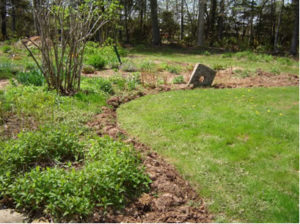
The perennial garden is designed to provide a constantly changing palette of colors throughout the growing season.
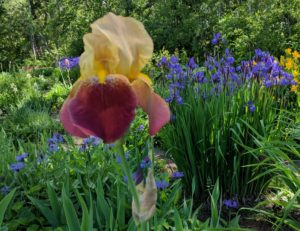
Located towards the back of the gardens, the orchard contains several of the original apple trees, including Yellow Transparent, Macintoshes, and Spartans. We continue to maintain the orchard by replacing dying trees with young, heritage varieties of apples.
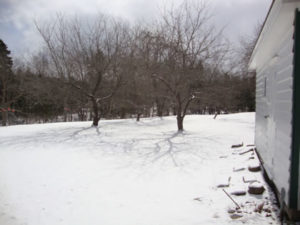
The following trees were planted in memory of special people from the Wallace area:
- Royal Red Maple, in memory of Margaret Ann Heard, 1934-1999
- Little Leaf Linden, planted June 2, 1996, in memory of Carolyn Stella Drysdale 1938-1992.
- Cut Leaf Silver Maple planted on June 2, 1996 in memory of Helen Patricia Moody 1919-1995.
- Forsythia, planted for Lois (Tiny) Smith.
- Red Maple, planted for David Cook.
Our legacy:
You can see from the photographs of the Davison-Kennedy property that there have been many changes to the gardens through the years. The Society inherited a sad remnant of the gardens maintained here by John Kennedy in his heyday. The gardens we enjoy today are the result of countless hours of labour over time. We owe a debt of gratitude to the Society for its belief in the historic value of this property and its special acres.
Take time to tour the gardens! Afterward, please join us in our lovely screened porch for a cup of tea and a sweet or two, served on Wednesday afternoons at 2 pm throughout July and August.
